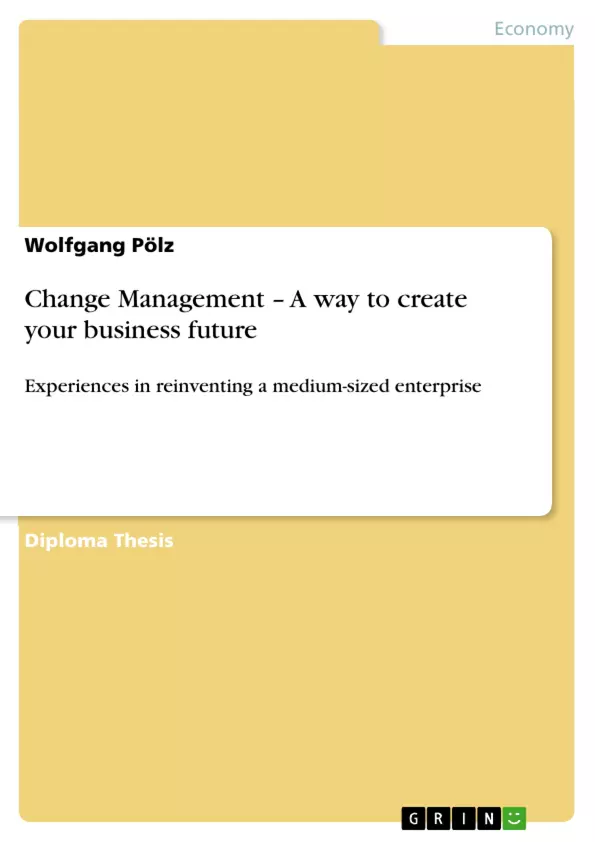First, this thesis includes an account of the entire process of deploying a change management project, as experienced at Datentechnik.
This study also gives a detailed "road map" and the hours required for each part of the transformation.
The second outcome of this thesis is a description of what to do after finishing a change management project. This includes methods to assure continuous improvement and ongoing learning in this new organizational environment. In other words, this is a brief description of how to switch over from rule-breaking and sporadic improvement to moderate but continual improvement.
Third, this description also includes the difficulties and lessons learned in the course of the project, giving an answer to the question, "What would you do if you could start all over again?".
Fourth, this thesis includes a detailed review of literature on change management and organizational transformation. In other words, it includes a comparison of several approaches to change management and various management methods such as TQM, ISO 9001 and so on.
Table of Contents
- 1 Abbreviations
- 2 Introduction
- 2.1 Motivation and Background
- 2.2 Objectives
- 2.3 Results of this thesis
- 3 Creating your business future
- 3.1 General conspectus:
- 3.1.1 Organizational development concepts
- 3.1.1.1 Localized exploitation
- 3.1.1.2 Horizontal (internal) integration
- 3.1.1.3 Business process redesign
- 3.1.1.4 Business network redesign
- 3.1.1.5 Business scope redefinition
- 3.1.2 The "transformation funnel"
- 3.1.1 Organizational development concepts
- 3.2
- 3.2.1 Values
- 3.2.2 Purpose statement
- 3.2.3 Sense of urgency
- 3.2.4 Guiding coalition
- 3.2.5 Value proposition
- 3.2.6 Vision
- 3.2.7 Mission
- 3.2.8 Strategy and goals
- 3.2.9 Timeline and supplementary aspects
- 3.3 Process redesign
- 3.3.1 Organizational structure
- 3.3.2 Building blocks for process reengineering
- 3.3.2.1 Terms and definitions
- 3.3.2.2 A process redesign roadmap
- 3.3.3 Process redesign teams
- 3.3.4 Timeline and supplementary process redesign aspects
- 3.4 Implementation
- 3.4.1 Building blocks for implementation
- 3.4.1.1 Process implementation
- 3.4.1.2 Organizational implementation
- 3.4.1.3 IM and IT implementation
- 3.4.2 Timeline and supplementary implementation aspects
- 3.4.1 Building blocks for implementation
- 3.5 Beyond change management
- 3.5.1 Continuous improvement
- 3.5.2 Measurement
- 3.5.3 Supplementary aspects
- 3.5.3.1 Pitfalls to avoid
Objectives and Key Themes
This thesis aims to provide a comprehensive overview of change management practices in the context of reinventing a medium-sized enterprise. It explores key concepts, methodologies, and real-world experiences to guide businesses through successful transformations.
- Organizational Development Concepts
- Process Redesign and Reengineering
- Implementation Strategies and Challenges
- Beyond Change Management: Continuous Improvement and Measurement
- Real-world Experiences and Case Studies
Chapter Summaries
Chapter 2 provides an introduction to the topic, outlining the motivation for the thesis, the objectives, and the expected outcomes. It sets the stage for the subsequent chapters by establishing the context of change management in a medium-sized enterprise.
Chapter 3 delves into the core of change management, exploring various concepts, methodologies, and frameworks. It covers topics such as organizational development, process redesign, and implementation strategies. This chapter also presents key elements of the "transformation funnel" which serves as a practical guide for successful change initiatives.
Chapter 3 continues by examining the practical aspects of process redesign. It focuses on building blocks for process reengineering, including terms and definitions, roadmap development, and the role of process redesign teams. This chapter also highlights the importance of establishing clear timelines and managing supplementary aspects to ensure a smooth process redesign.
Chapter 3 concludes by exploring the critical stage of implementation. It delves into the building blocks for successful implementation, covering aspects such as process implementation, organizational implementation, and IT integration. This chapter also examines the importance of setting clear goals and addressing the demands on the organization throughout the implementation phase.
Keywords
This thesis focuses on the key concepts of change management, process redesign, organizational development, continuous improvement, and measurement. It highlights real-world experiences and case studies to illustrate the practical application of these principles in the context of reinventing a medium-sized enterprise.
- 3.1 General conspectus:
- Arbeit zitieren
- Ing. Mag.(FH), MSc Wolfgang Pölz (Autor:in), 2002, Change Management – A way to create your business future, München, GRIN Verlag, https://www.grin.com/document/89904



